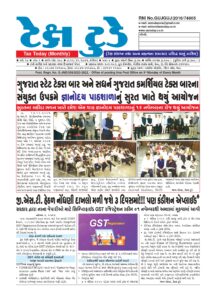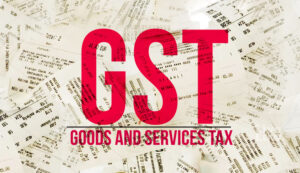GST WEEKLY UPDATE : 41/2021-22 (09.01.2022) by CA Vipul Khandhar

By CA Vipul Khandhar, Ahmedabad
(The author is a well known Chartered Accountant practicing at Ahmedabad)
- GST portal allow to file Option to sent request to supplier for filling of GST return:
The tab/ option Communicate on GST portal for the filling of the GSTR-1 return, An option has been enabled wherein the supplier can request the recipient to file GST 1 so as to avail ITC benefit. On such request message goes to the recipient is received on the registered mobile number and e mail I’d of the recipient to make the supplier aware of the impending request by the recipient. So that supplier can take timely action on the basis of this notification and can ensure to file GST 1 within the deadline of 11th/13th of Next month so that the recipient can take timely ITC credit. Similarly, credit notes, debit notes request can be made by the supplier / recipient.
- Upcoming functionality – Interest Calculator in GSTR-3B:
As a facilitation measure for taxpayers & for assisting the taxpayers in doing a correct self-assessment, a new functionality of interest calculator is being released in GSTR-3B. This functionality will arrive at the system computed interest on the basis of the tax liability values declared by the taxpayers. The interest applicable, if any, on the tax liability declared in the GSTR-3B of a particular tax-period will be computed after the filing of the said GSTR-3B. These system computed interest values will be auto-populated in the Table-5.1 of the GSTR-3B of the next tax-period. This functionality also assists the taxpayers in doing correct computation of interest for the liability of any past period declared in the GSTR-3B for the current tax period, based on the details furnished by them on the portal. This functionality INTEREST CALCULATOR IN GSTR-3B Introducing Interest calculator
- To facilitate taxpayers in doing self-assessment, the new functionality of interest calculator is being released in GSTR-3B. This functionality will assist taxpayers in calculating the interest applicable for delayed filing of returns. Taxpayers will have to verify and discharge the correct interest liability as per law, as payment of interest is a statutory compliance. Interest computation.
- The interest computed by the system has been aligned with the Section-5o of the CGST Act, 2017, as amended. Consequently, interest liability for respect of supplies made during the present tax-period and declared in the GSTR-3B for this period will be calculated only on that portion of the tax which is paid by debiting the electronic cash ledger, e., tax paid in cash. With respect to the liability pertaining to the previous tax-period(s), and paid in later GSTR-3B, the interest will be computed for the entire liability, whether paid by debiting the electronic cash ledger or electronic credit ledger. Auto-population of system computed interest
- This new functionality will compute the minimum interest applicable on the basis of the values declared by the taxpayers in GSTR-3B for a particular tax-period. This system computed interest will be auto-populated in Table-5.1 of GSTR-3B for the next tax-period, the way it is done for the Late fees at present. 4. The system computed interest values auto-populated in next GSTR-3B return will be kept editable, initially. However, the system generated PDF of filed GSTR-3B will contain both values: the System computed interest, and the user paid interest values. Scenarios where interest is applicable
- Interest liability can arise in cases of either of the following, or both : i. Delayed filing of return: If the present GSTR-3B is filed after the ‘due date’, then interest will be applicable at prescribed rate of interest from the `due date’ of GSTR-3B for relevant period i.e. till the date of filing of the return. ii. Delayed declaration of liability: If the liability pertaining to previous tax-periods is discharged in the present GSTR-3B, then interest will be leviable from the `due date’ of return for the said previous period till the date of declaration of the liability in the return. Thus, as part of the interest calculator, a new feature has been provided to GSTR-3B for allowing taxpayers to voluntarily declare Tax-period wise break-up of If a taxpayer is discharging liability for any past period(s) in the present GSTR3B, then exact tax-period wise break-up of the same can be provided by the taxpayers. The interest will be thereafter computed by the system accordingly.
- Furnishing tax-period wise break-up in GSTR-3B: The return in FORM GSTR-3B, as it is now, allows taxpayers to discharge tax liability for previous tax-periods also, in addition to the tax liability for the present period. However, the tax-period wise break-up of the tax liability is not available in GSTR-3B. Thus, for computing the exact interest liability, the information regarding the tax-period wise break-up of the consolidated tax liability declared by the taxpayer would be required by the system.
- In view of above, a new button has been added in GSTR-3B, called Tax Liability Breakup (Voluntary), and data is to be entered by clicking this button only by those taxpayers who are making payment for liability pertaining to earlier tax-periods in the present GSTR In cases where the present GSTR-3B consists of liability only for the present period, the taxpayers can ignore this button, and continue filing their return as usual. Changes in user experience 8. Taxpayers filing on or before Due date of GSTR-3B: After the interest calculator is enabled on the GST Portal, there will be no change in the user experience for the taxpayers who file their return on or before the ‘ due date’. The taxpayer would still have the facility to provide the break-up of liability of the past period(s). For details of declaring tax-period wise tax liability.
- Taxpayer filing GSTR-3B after Due date: For taxpayers who are filing after `due date’, a pop-up will be shown regarding the option to declare tax-period wise tax liability, if applicable to them. If they have any tax liability pertaining to any previous tax-period to declare, they may declare the same. If the entire liability pertains to the present period, then they may ignore this pop-up message, and continue their filing as usual. If no previous period tax liability is declared, by default the interest will be computed by assuming that the entire tax liability pertains to the present period.
- GSTN issues Advisory on Revamped Search HSN Code Functionality:
- The Goods and Service Tax Networks (GSTN) has issued the advisory on revamped Search HSN Code Functionality. The taxpayer can search HSN/ Description using either of the two options which are provided as radio buttons:
(i) HSN and
(ii) Description;
either of which can be selected as per the requirement. The Search of description on the basis of HSN Taxpayer can search for any HSN Code pertaining to any goods and/or services; Only numbers are allowed to be entered in the search box if search is based on HSN; On entering of HSN in search box, five nearest possible descriptions would be shown in the auto-suggest dropdown relating to the said HSN; The taxpayers can then select the suggestion that may be most relevant to their case. It is noteworthy that the drop down will be shown only when a minimum of three characters are entered in the search box, and; the maximum number of characters allowed in the search box is eight. In the search results, the taxpayer will be able to view the top three most commonly used trade descriptions of the said goods or services in the database along with their respective technical descriptions. Taxpayers can also view other HSN Codes related to the search. For instance, in case a 4-digit HSN code is searched, the related 6-digit and 8-digit HSN code will also be shown under “Other related HSN code(s)” in the resultant table. Similarly, in case a 6-digit HSN code is searched, the related 8-digit HSN code will also be shown. However, in case an 8-digit HSN code is searched, related HSN will not be shown in the table as 8-digit code in itself is the most accurate. The related HSN Codes displayed in the resultant table are hyperlinked and taxpayers can click on the same to view further details of the said HSN. In case taxpayers are not able to find HSN of any goods or services, then they can raise a ticket on GST Self-Service Portal (https://selfservice.gstsystem.in). Further, taxpayers can also download the entire list of HSN Codes along with their technical descriptions in excel format by clicking on link ‘Download HSN in Excel Format’ available at bottom of page.
- CBIC issues Guidelines for Recovery Proceedings under CGST Act, 2017:
- The Central Board of Indirect Taxes and Customs (CBIC) has issued the guidelines for recovery proceedings under the provisions of section 79 of the CGST Act, 2017 in cases covered under explanation to sub-section (12) of section 75 of the CGST Act, 2017. Sub-section (12) of section 75 of the CGST Act, 2017 provides that notwithstanding anything contained in section 73 or section 74 of the Act.
- Where any amount of self-assessed tax in accordance with the return furnished under section 39 remains unpaid, either wholly or partly, or any amount of interest payable on such tax remains unpaid, the same shall be recovered under the provisions of section 79. An explanation has been added to subsection (12) of section 75 vide section 114 of the Finance Act, 2021 with effect from 01.01.2022 to clarify that “self-assessed tax” shall include the tax payable in respect of outward supplies, the details of which have been furnished under section 37 but not included in the return furnished under section 39.
- Where the payable in respect of details of outward supplies furnished by the registered person in GSTR-1, has not been paid through GSTR-3B return, either wholly or partly, or any amount of interest payable on such tax remains unpaid, then in such cases, the tax short paid on such self-assessed and thus self-admitted liability, and the interest thereon, are liable to be recovered under the provisions of section 79. There may, however, be some cases where there may be a genuine reason for the difference between the details of outward supplies declared in GSTR-1 and those declared in GSTR-3B.
- For example, the person may have made a typographical error or may have wrongly reported any detail in GSTR-1 or GSTR-3B. Such errors or omissions can be rectified by the said person in a subsequent GSTR-1/ GSTR-3B as per the provisions of sub-section (3) of section 37 or the provisions of sub-section (9) of section 39, as the case may be.
- There may also be cases, where a supply could not be declared by the registered person in GSTR-1 of an earlier tax period, though the tax on the same was paid by correctly reporting the said supply in GSTR-3B. The details of such supply may now be reported by the registered person in the GSTR-1 of the current tax period.
- In such cases, there could be a mismatch between GSTR-1 and GSTR-3B (liability reported in GSTR-1 tax paid in GSTR-3B) in the current tax period.
- Therefore, in all such cases, an opportunity needs to be provided to the concerned registered person to explain the differences between GSTR-1 and GSTR-3B, if any, and for short payment or nonpayment of the amount of self-assessed tax liability, and interest thereon.
- Before any action under section 79 of the Act is taken for recovery of the said amount. “Accordingly, where ever any such amount of tax, self-assessed by the registered person in his outward supply statement GSTR-1 is found to be short paid or not paid by the said person through his GSTR-3B return in terms of the provisions of sub-section (12) of section 75 of the Act, the proper officer may send a communication (with DIN, in terms of guidelines issued vide Circular No. 122/41/2019-GST dated 5th November 2019) to the registered person to pay the amount short paid or not paid or to explain the reasons for such short payment or non-payment of self-assessed tax, within a reasonable time, as prescribed in the communication. If the concerned person is able to justify the differences between GSTR-1 and GSTR-3B or is able to explain the reasons for such short-payment or non-payment of tax, to the satisfaction of the proper officer, or pays the amount such short paid or not paid, then there may not be any requirement to initiate proceedings for recovery under section 79,” the Instruction by CBIC.
Disclaimer:
This publication contains information for general guidance only. It is not intended to address the circumstances of any particular individual or entity. Although the best of endeavour has been made to provide the provisions in a simpler and accurate form, there is no substitute to detailed research with regard to the specific situation of a particular individual or entity. We do not accept any responsibility for loss incurred by any person for acting or refraining to act as a result of any matter in this publication.






